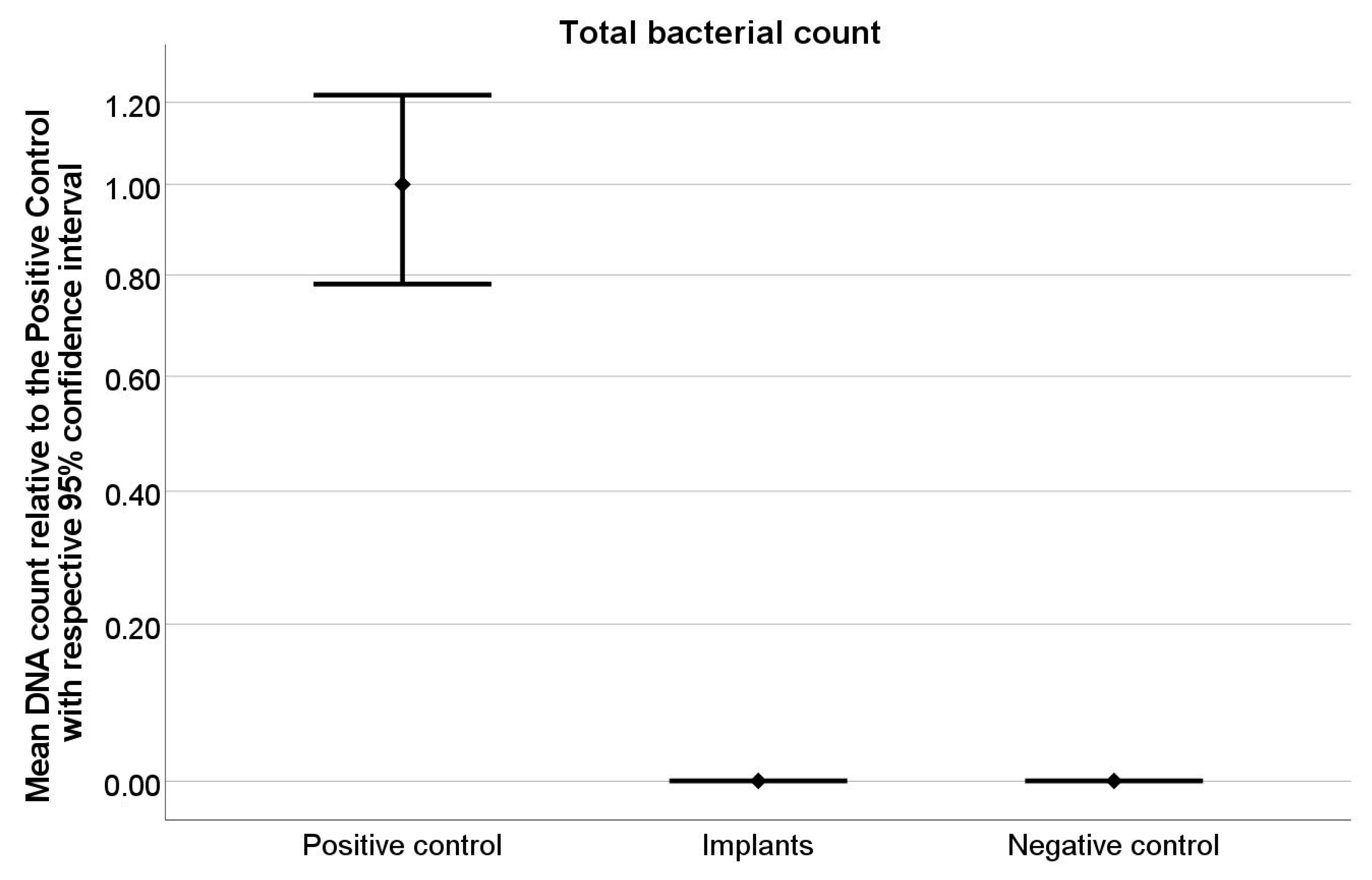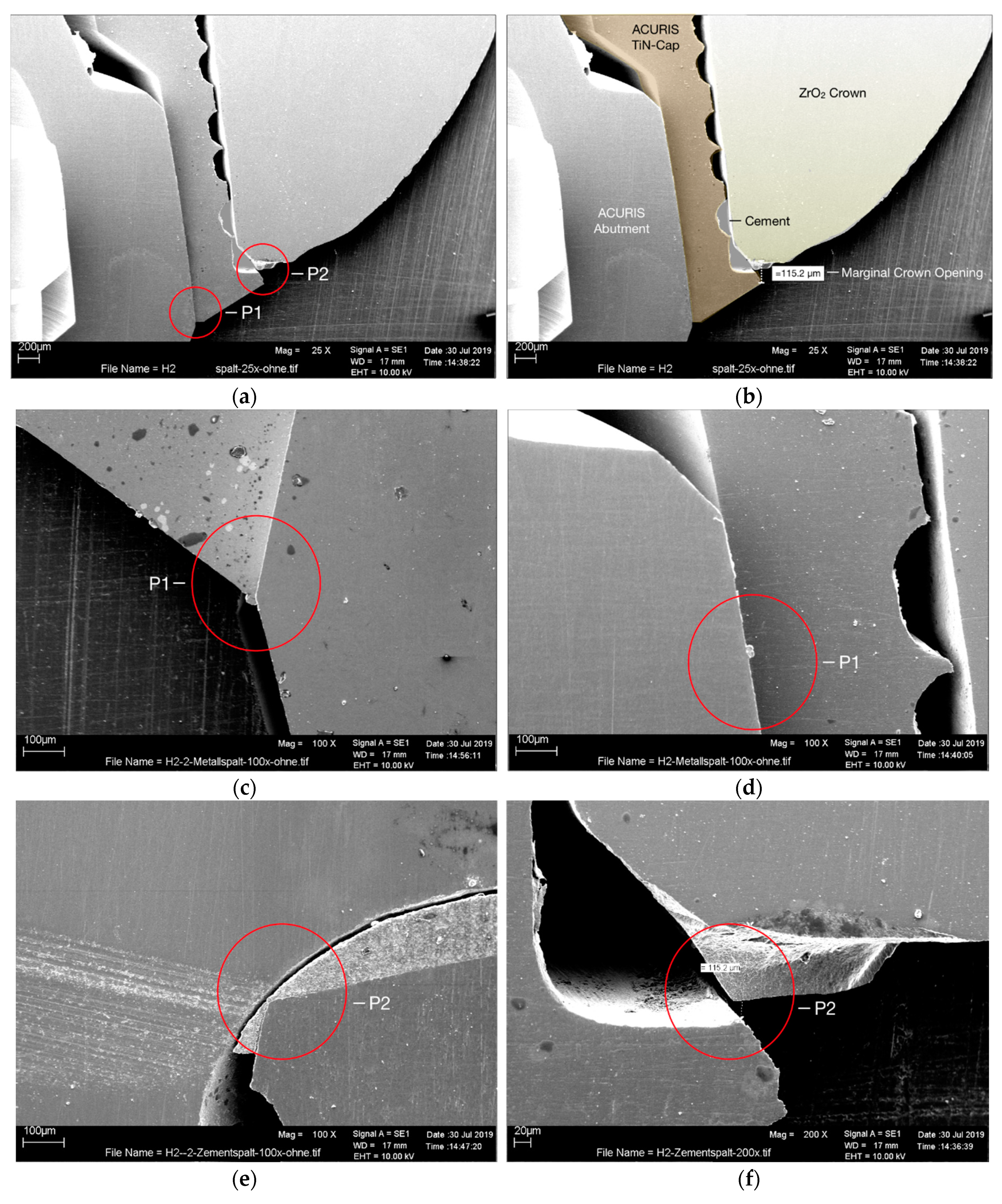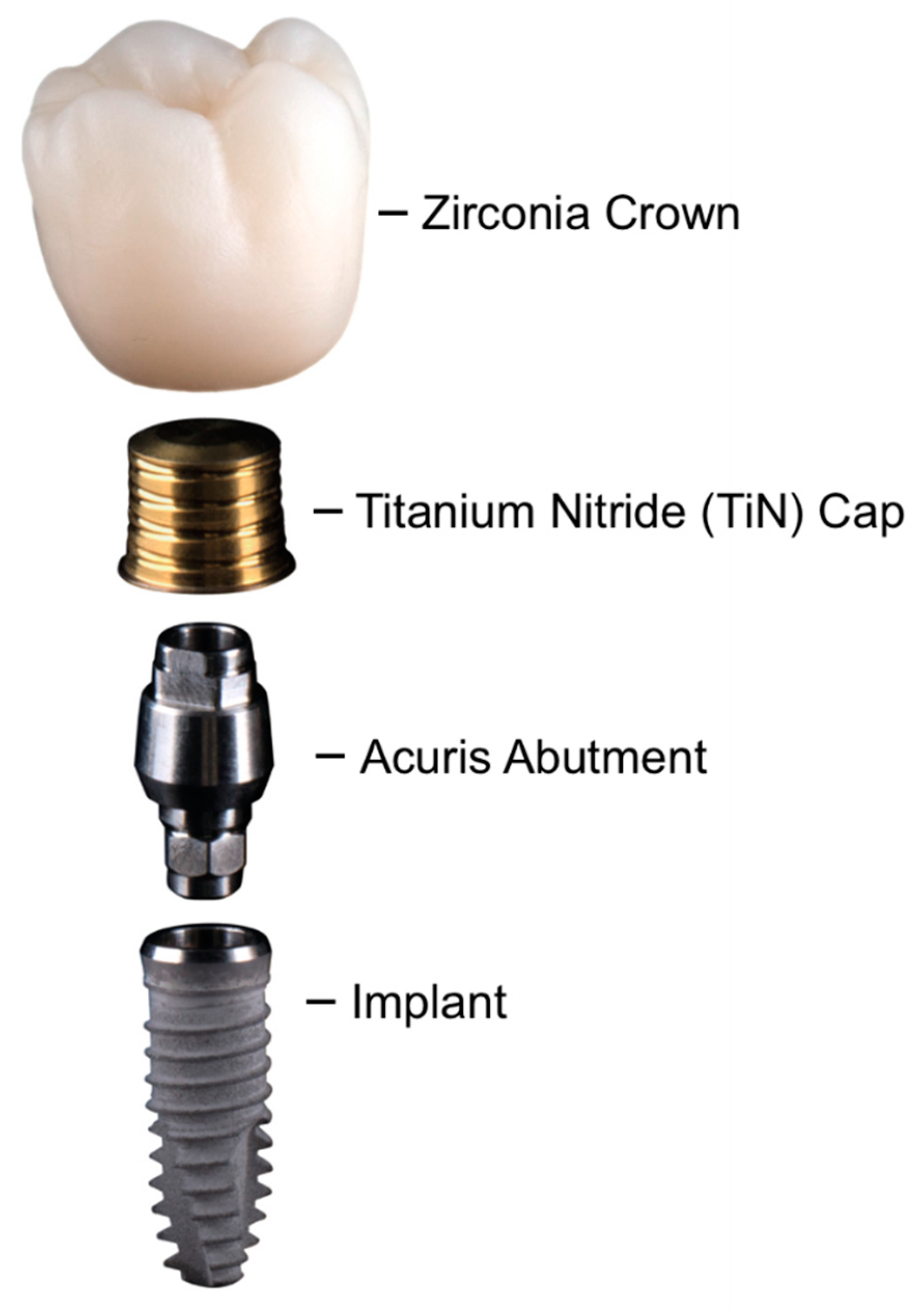Marginal Adaptation and Microbial Leakage at Conometric Prosthetic Connections for Implant-Supported Single Crowns: An In Vitro Investigation
Abstract
:1. Introduction
2. Results
2.1. Bacterial Exit Out of the System
2.2. Bacterial Entry into the System
2.3. Scanning Electron Microscopy
3. Discussion
4. Materials and Methods
4.1. General Study Set-Up
4.2. Bacterial Exit Out of the System
4.3. Bacterial Entry into the System
4.4. Scanning Electron Microscopy
4.5. Statistical Analysis
5. Conclusions
Author Contributions
Funding
Institutional Review Board Statement
Informed Consent Statement
Data Availability Statement
Acknowledgments
Conflicts of Interest
References
- Pjetursson, B.E.; Thoma, D.; Jung, R.; Zwahlen, M.; Zembic, A. A systematic review of the survival and complication rates of implant-supported fixed dental prostheses (FDPs) after a mean observation period of at least 5 years. Clin. Oral Implant. Res. 2012, 23 (Suppl. 6), 22–38. [Google Scholar] [CrossRef]
- Tey, V.H.S.; Phillips, R.; Tan, K. Five-year retrospective study on success, survival and incidence of complications of single crowns supported by dental implants. Clin. Oral Implant. Res. 2017, 28, 620–625. [Google Scholar] [CrossRef]
- Sailer, I.; Muhlemann, S.; Zwahlen, M.; Hammerle, C.H.; Schneider, D. Cemented and screw-retained implant reconstructions: A systematic review of the survival and complication rates. Clin. Oral Implant. Res. 2012, 23, 163–201. [Google Scholar] [CrossRef]
- Wittneben, J.G.; Millen, C.; Bragger, U. Clinical performance of screw- versus cement-retained fixed implant-supported reconstructions--a systematic review. Int. J. Oral Maxillofac. Implants 2014, 29 (Suppl. 6), 84–98. [Google Scholar] [CrossRef] [Green Version]
- Millen, C.; Bragger, U.; Wittneben, J.G. Influence of prosthesis type and retention mechanism on complications with fixed implant-supported prostheses: A systematic review applying multivariate analyses. Int. J. Oral Maxillofac. Implants 2015, 30, 110–124. [Google Scholar] [CrossRef] [Green Version]
- Degidi, M.; Nardi, D.; Sighinolfi, G.; Degidi, D. The conometric concept for the definitive rehabilitation of a single posterior implant by using a conical indexed abutment: A technique. J. Prosthet. Dent. 2020, 123, 576–579. [Google Scholar] [CrossRef]
- Scarano, A.; Piattelli, M.; Vrespa, G.; Caputi, S.; Piattelli, A. Bacterial adhesion on titanium nitride-coated and uncoated implants: An in vivo human study. J. Oral Implantol. 2003, 29, 80–85. [Google Scholar] [CrossRef]
- Annunziata, M.; Oliva, A.; Basile, M.A.; Giordano, M.; Mazzola, N.; Rizzo, A.; Lanza, A.; Guida, L. The effects of titanium nitride-coating on the topographic and biological features of TPS implant surfaces. J. Dent. 2011, 39, 720–728. [Google Scholar] [CrossRef]
- Sanz-Sanchez, I.; Sanz-Martin, I.; Carrillo de Albornoz, A.; Figuero, E.; Sanz, M. Biological effect of the abutment material on the stability of peri-implant marginal bone levels: A systematic review and meta-analysis. Clin. Oral Implant. Res. 2018, 29 (Suppl. 18), 124–144. [Google Scholar] [CrossRef] [Green Version]
- Ioannidis, A.; Cathomen, E.; Jung, R.E.; Fehmer, V.; Husler, J.; Thoma, D.S. Discoloration of the mucosa caused by different restorative materials—A spectrophotometric in vitro study. Clin. Oral Implant. Res. 2016, 28, 1133–1138. [Google Scholar] [CrossRef] [Green Version]
- Sala, L.; Bascones-Martinez, A.; Carrillo-de-Albornoz, A. Impact of abutment material on peri-implant soft tissue color. An In Vitro study. Clin. Oral Investig. 2016, 21, 2221–2233. [Google Scholar] [CrossRef]
- Degidi, M.; Nardi, D.; Piattelli, A. The Conometric Concept: Coupling Connection for Immediately Loaded Titanium-Reinforced Provisional Fixed Partial Dentures-A Case Series. Int. J. Periodont. Restor. Dent. 2016, 36, 347–354. [Google Scholar] [CrossRef] [Green Version]
- Bressan, E.; Lops, D. Conometric retention for complete fixed prosthesis supported by four implants: 2-years prospective study. Clin. Oral Implant. Res. 2014, 25, 546–552. [Google Scholar] [CrossRef]
- Degidi, M.; Nardi, D.; Sighinolfi, G.; Piattelli, A. The Conometric Concept: Definitive Fixed Lithium Disilicate Restorations Supported by Conical Abutments. J. Prosthodont. 2018, 27, 605–610. [Google Scholar] [CrossRef]
- Degidi, M.; Nardi, D.; Sighinolfi, G.; Degidi, D.; Piattelli, A. The Conometric Concept: A Two-Year Follow-Up of Fixed Partial CEREC Restorations Supported by Cone-In-Cone Abutments. J. Prosthodont. 2019, 28, e780–e787. [Google Scholar] [CrossRef]
- Bressan, E.; Venezze, A.C.; Magaz, V.R.; Lops, D.; Ghensi, P. Fixed Conometric Retention with CAD/CAM Conic Coupling Abutments and Prefabricated Syncone Caps: A Case Series. Int. J. Periodont. Restor. Dent. 2018, 38, 277–280. [Google Scholar] [CrossRef]
- Krebs, M.; Kesar, N.; Begic, A.; von Krockow, N.; Nentwig, G.H.; Weigl, P. Incidence and prevalence of peri-implantitis and peri-implant mucositis 17 to 23 (18.9) years postimplant placement. Clin. Implant. Dent. Relat. Res. 2019, 21, 1116–1123. [Google Scholar] [CrossRef]
- Dibart, S.; Warbington, M.; Su, M.F.; Skobe, Z. In vitro evaluation of the implant-abutment bacterial seal: The locking taper system. Int. J. Oral Maxillofac. Implants 2005, 20, 732–737. [Google Scholar]
- Koutouzis, T.; Wallet, S.; Calderon, N.; Lundgren, T. Bacterial colonization of the implant-abutment interface using an in vitro dynamic loading model. J. Periodontol. 2011, 82, 613–618. [Google Scholar] [CrossRef]
- Bressan, E.; Stocchero, M.; Jimbo, R.; Rosati, C.; Fanti, E.; Tomasi, C.; Lops, D. Microbial Leakage at Morse Taper Conometric Prosthetic Connection: An In Vitro Investigation. Implant. Dent. 2017, 26, 756–761. [Google Scholar] [CrossRef]
- Canullo, L.; Penarrocha, M.; Monje, A.; Catena, A.; Wang, H.L.; Penarrocha, D. Association Between Clinical and Microbiologic Cluster Profiles and Peri-implantitis. Int. J. Oral Maxillofac. Implants 2017, 32, 1054–1064. [Google Scholar] [CrossRef] [PubMed]
- Caricasulo, R.; Malchiodi, L.; Ghensi, P.; Fantozzi, G.; Cucchi, A. The influence of implant-abutment connection to peri-implant bone loss: A systematic review and meta-analysis. Clin. Implant. Dent. Relat. Res. 2018, 20, 653–664. [Google Scholar] [CrossRef] [PubMed]
- Lauritano, D.; Moreo, G.; Lucchese, A.; Viganoni, C.; Limongelli, L.; Carinci, F. The Impact of Implant-Abutment Connection on Clinical Outcomes and Microbial Colonization: A Narrative Review. Materials 2020, 13, 1131. [Google Scholar] [CrossRef] [PubMed] [Green Version]
- Da Silva-Neto, J.P.; Nobilo, M.A.; Penatti, M.P.; Simamoto, P.C., Jr.; das Neves, F.D. Influence of methodologic aspects on the results of implant-abutment interface microleakage tests: A critical review of in vitro studies. Int. J. Oral Maxillofac. Implants 2012, 27, 793–800. [Google Scholar]
- Canullo, L.; Penarrocha-Oltra, D.; Soldini, C.; Mazzocco, F.; Penarrocha, M.; Covani, U. Microbiological assessment of the implant-abutment interface in different connections: Cross-sectional study after 5 years of functional loading. Clin. Oral Implants Res. 2015, 26, 426–434. [Google Scholar] [CrossRef] [PubMed]
- Limkangwalmongkol, P.; Chiche, G.J.; Blatz, M.B. Precision of fit of two margin designs for metal-ceramic crowns. J. Prosthodont. 2007, 16, 233–237. [Google Scholar] [CrossRef]
- McLean, J.W.; von Fraunhofer, J.A. The estimation of cement film thickness by an in vivo technique. Br. Dent. J. 1971, 131, 107–111. [Google Scholar] [CrossRef]
- Hong, M.H.; Min, B.K.; Lee, D.H.; Kwon, T.Y. Marginal fit of metal-ceramic crowns fabricated by using a casting and two selective laser melting processes before and after ceramic firing. J. Prosthet. Dent. 2019, 122, 475–481. [Google Scholar] [CrossRef]
- Memari, Y.; Mohajerfar, M.; Armin, A.; Kamalian, F.; Rezayani, V.; Beyabanaki, E. Marginal Adaptation of CAD/CAM All-Ceramic Crowns Made by Different Impression Methods: A Literature Review. J. Prosthodont. 2019, 28, e536–e544. [Google Scholar] [CrossRef]
- Ahrberg, D.; Lauer, H.C.; Ahrberg, M.; Weigl, P. Evaluation of fit and efficiency of CAD/CAM fabricated all-ceramic restorations based on direct and indirect digitalization: A double-blinded, randomized clinical trial. Clin. Oral Investig. 2016, 20, 291–300. [Google Scholar] [CrossRef]
- Zipprich, H.; Miatke, S.; Hmaidouch, R.; Lauer, H.C. A New Experimental Design for Bacterial Microleakage Investigation at the Implant-Abutment Interface: An In Vitro Study. Int. J. Oral Maxillofac. Implants 2016, 31, 37–44. [Google Scholar] [CrossRef] [PubMed] [Green Version]
- Bressan, E.; Sbricoli, L.; Guazzo, R.; Bambace, M.; Lops, D.; Tomasi, C. Five-year prospective study on conometric retention for complete fixed prostheses. Int. J. Oral Implantol. 2019, 12, 105–113. [Google Scholar]
- Sampaio-Maia, B.; Caldas, I.M.; Pereira, M.L.; Perez-Mongiovi, D.; Araujo, R. The Oral Microbiome in Health and Its Implication in Oral and Systemic Diseases. Adv. Appl. Microbiol. 2016, 97, 171–210. [Google Scholar] [PubMed]
- Carrouel, F.; Viennot, S.; Santamaria, J.; Veber, P.; Bourgeois, D. Quantitative Molecular Detection of 19 Major Pathogens in the Interdental Biofilm of Periodontally Healthy Young Adults. Front. Microbiol. 2016, 7, 840. [Google Scholar] [CrossRef] [PubMed]
- Hoshino, T.; Kawaguchi, M.; Shimizu, N.; Hoshino, N.; Ooshima, T.; Fujiwara, T. PCR detection and identification of oral streptococci in saliva samples using gtf genes. Diagn. Microbiol. Infect. Dis. 2004, 48, 195–199. [Google Scholar] [CrossRef] [PubMed]




| Specimens | Day 1 mg/mL | Day 2 mg/mL | Day 3 mg/mL | Day 4 mg/mL |
|---|---|---|---|---|
| Positive Control | 2.812127 | 1.35693 | 0.540473 | 0.216807 |
| Implant 1 | 0.000572 | 0.000623 | 0.000709 | 0.000643 |
| Implant 2 | 0.000638 | 0.00062 | 0.000633 | 0.000611 |
| Implant 3 | 0.000598 | 0.000616 | 0.000648 | 0.000671 |
| Implant 4 | 0.000587 | 0.000634 | 0.000657 | 0.000657 |
| Implant 5 | 0.000592 | 0.000634 | 0.000675 | 0.000625 |
| Implant 6 | 0.000583 | 0.000664 | 0.000629 | 0.00061 |
| Implant 7 | 0.000633 | 0.000622 | 0.000684 | 0.000622 |
| Implant 8 | 0.000643 | 0.000644 | 0.000609 | 0.000653 |
| Negative Control | 0.000646 | 0.000613 | 0.000642 | 0.000638 |
| Differences of Groups/Least Squares Means | |||||||||
|---|---|---|---|---|---|---|---|---|---|
| Group | Group | Estimation | Standard Error | DF | t-Wert | Pr > |t| | Alpha | Lower | Upper |
| Positive Control | Negative Control | 7.5188 | 0.7192 | 36 | 10.45 | <0.0001 | 0.05 | 6.0602 | 8.9775 |
| Positive Control | Test specimens | 7.5211 | 0.5471 | 36 | 13.75 | <0.0001 | 0.05 | 6.4115 | 8.6307 |
| Negative Control | Test specimens | 0.002268 | 0.5303 | 36 | 0.00 | 0.9966 | 0.05 | −1.0733 | 1.0778 |
| Type III Test of Effects | ||||
|---|---|---|---|---|
| Effect | No. DF | Den DF | F-Value | Pr > F |
| Day | 1 | 36 | 0.16 | 0.6910 |
| Group | 2 | 36 | 95.62 | <0.0001 |
| Organism | Primer | Primer Sequence | Reference of Primer Applicability |
|---|---|---|---|
| Porphyromonas | CA-PG-F/R | AGGCAGCTTGCCATACTGCG | Carrouel F. et al., |
| Gingivalis | ACTGTTAGCAACTACCGATGT | 2016 [34]. | |
| Streptococcus | MKD-FV/RV | GGCACCACAACATTGGGAAGCTCAG | Hoshino T. et al., |
| Mutans | GGAATGGCCGCTAAGTCAACAGG | 2004 [35]. | |
| Actinomyces | ACT-174-F | GGTCTCTGGGCCGTTACTGA | Ellerbrock B., |
| Species | ACT-281-R | GRCCCCCCACACCTAGTG | 2010 [UKD]. |
| Fusobacterium | CA-FN-F/R | AGAGTTTGATCCTGGCTCAG | Carrouel F. et al., |
| nucleatum | GTCATCGTGCACACAGAATTGCTG | 2016 [34]. |
Publisher’s Note: MDPI stays neutral with regard to jurisdictional claims in published maps and institutional affiliations. |
© 2021 by the authors. Licensee MDPI, Basel, Switzerland. This article is an open access article distributed under the terms and conditions of the Creative Commons Attribution (CC BY) license (http://creativecommons.org/licenses/by/4.0/).
Share and Cite
Gehrke, P.; Hartjen, P.; Smeets, R.; Gosau, M.; Peters, U.; Beikler, T.; Fischer, C.; Stolzer, C.; Geis-Gerstorfer, J.; Weigl, P.; et al. Marginal Adaptation and Microbial Leakage at Conometric Prosthetic Connections for Implant-Supported Single Crowns: An In Vitro Investigation. Int. J. Mol. Sci. 2021, 22, 881. https://doi.org/10.3390/ijms22020881
Gehrke P, Hartjen P, Smeets R, Gosau M, Peters U, Beikler T, Fischer C, Stolzer C, Geis-Gerstorfer J, Weigl P, et al. Marginal Adaptation and Microbial Leakage at Conometric Prosthetic Connections for Implant-Supported Single Crowns: An In Vitro Investigation. International Journal of Molecular Sciences. 2021; 22(2):881. https://doi.org/10.3390/ijms22020881
Chicago/Turabian StyleGehrke, Peter, Philip Hartjen, Ralf Smeets, Martin Gosau, Ulrike Peters, Thomas Beikler, Carsten Fischer, Carolin Stolzer, Jürgen Geis-Gerstorfer, Paul Weigl, and et al. 2021. "Marginal Adaptation and Microbial Leakage at Conometric Prosthetic Connections for Implant-Supported Single Crowns: An In Vitro Investigation" International Journal of Molecular Sciences 22, no. 2: 881. https://doi.org/10.3390/ijms22020881
APA StyleGehrke, P., Hartjen, P., Smeets, R., Gosau, M., Peters, U., Beikler, T., Fischer, C., Stolzer, C., Geis-Gerstorfer, J., Weigl, P., & Schäfer, S. (2021). Marginal Adaptation and Microbial Leakage at Conometric Prosthetic Connections for Implant-Supported Single Crowns: An In Vitro Investigation. International Journal of Molecular Sciences, 22(2), 881. https://doi.org/10.3390/ijms22020881






